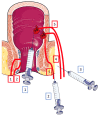Adipose-Derived Stem Cells in the Treatment of Perianal Fistulas in Crohn's Disease: Rationale, Clinical Results and Perspectives
- PMID: 34576129
- PMCID: PMC8470328
- DOI: 10.3390/ijms22189967
Adipose-Derived Stem Cells in the Treatment of Perianal Fistulas in Crohn's Disease: Rationale, Clinical Results and Perspectives
Abstract
Between 20 to 25% of Crohn's disease (CD) patients suffer from perianal fistulas, a marker of disease severity. Seton drainage combined with anti-TNFα can result in closure of the fistula in 70 to 75% of patients. For the remaining 25% of patients there is room for in situ injection of autologous or allogenic mesenchymal stem cells such as adipose-derived stem/stromal cells (ADSCs). ADSCs exert their effects on tissues and effector cells through paracrine phenomena, including the secretome and extracellular vesicles. They display anti-inflammatory, anti-apoptotic, pro-angiogenic, proliferative, and immunomodulatory properties, and a homing within the damaged tissue. They also have immuno-evasive properties allowing a clinical allogeneic approach. Numerous clinical trials have been conducted that demonstrate a complete cure rate of anoperineal fistulas in CD ranging from 46 to 90% of cases after in situ injection of autologous or allogenic ADSCs. A pivotal phase III-controlled trial using allogenic ADSCs (Alofisel®) demonstrated that prolonged clinical and radiological remission can be obtained in nearly 60% of cases with a good safety profile. Future studies should be conducted for a better knowledge of the local effect of ADSCs as well as for a standardization in terms of the number of injections and associated procedures.
Keywords: Crohn’s disease; adipose-derived stem cells; allogenic stem cells; mesenchymal stem cells; perianal fistula.
Conflict of interest statement
The authors declare no conflict of interest.
Figures





References
Publication types
MeSH terms
LinkOut - more resources
Full Text Sources
Medical

